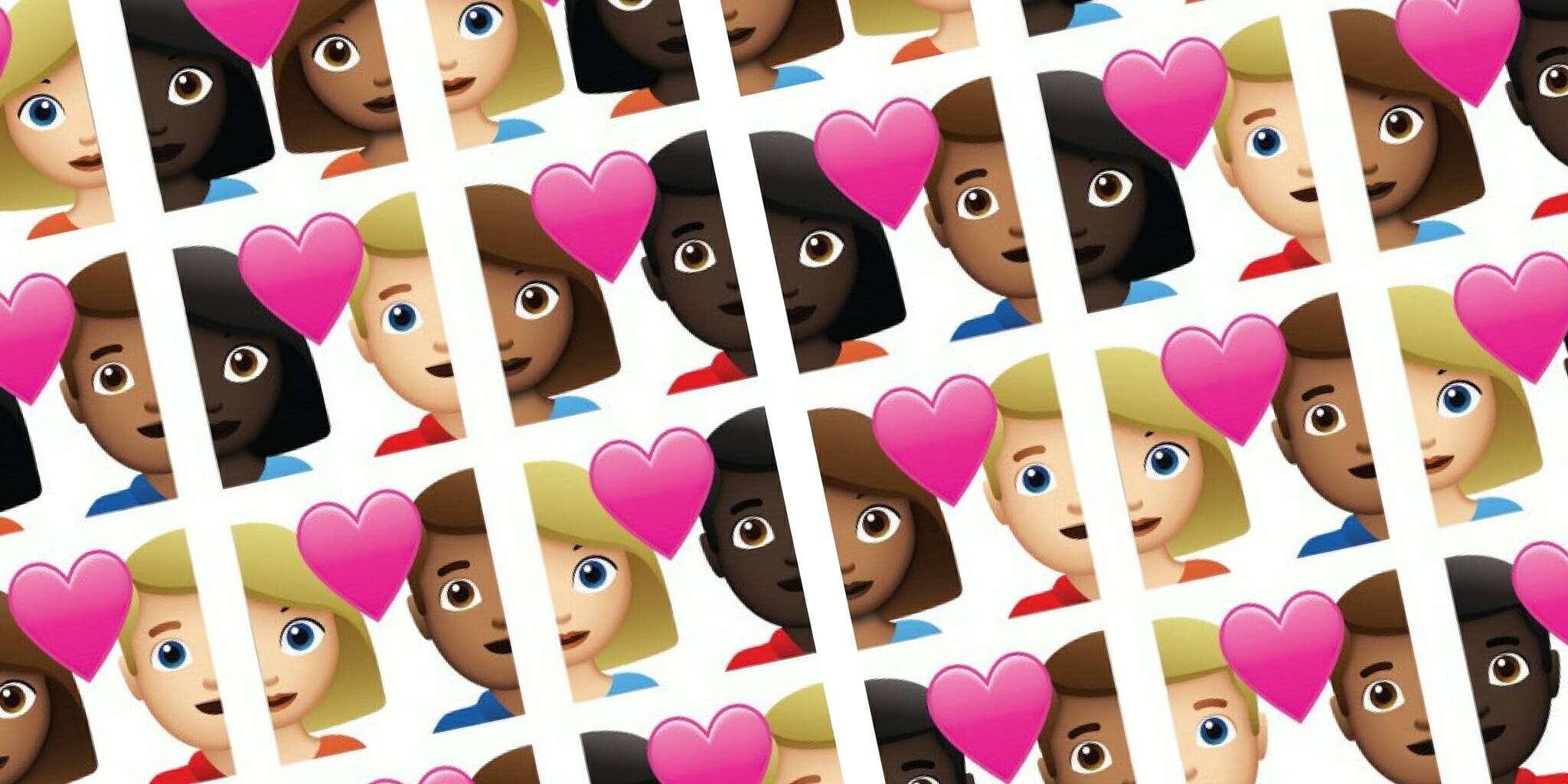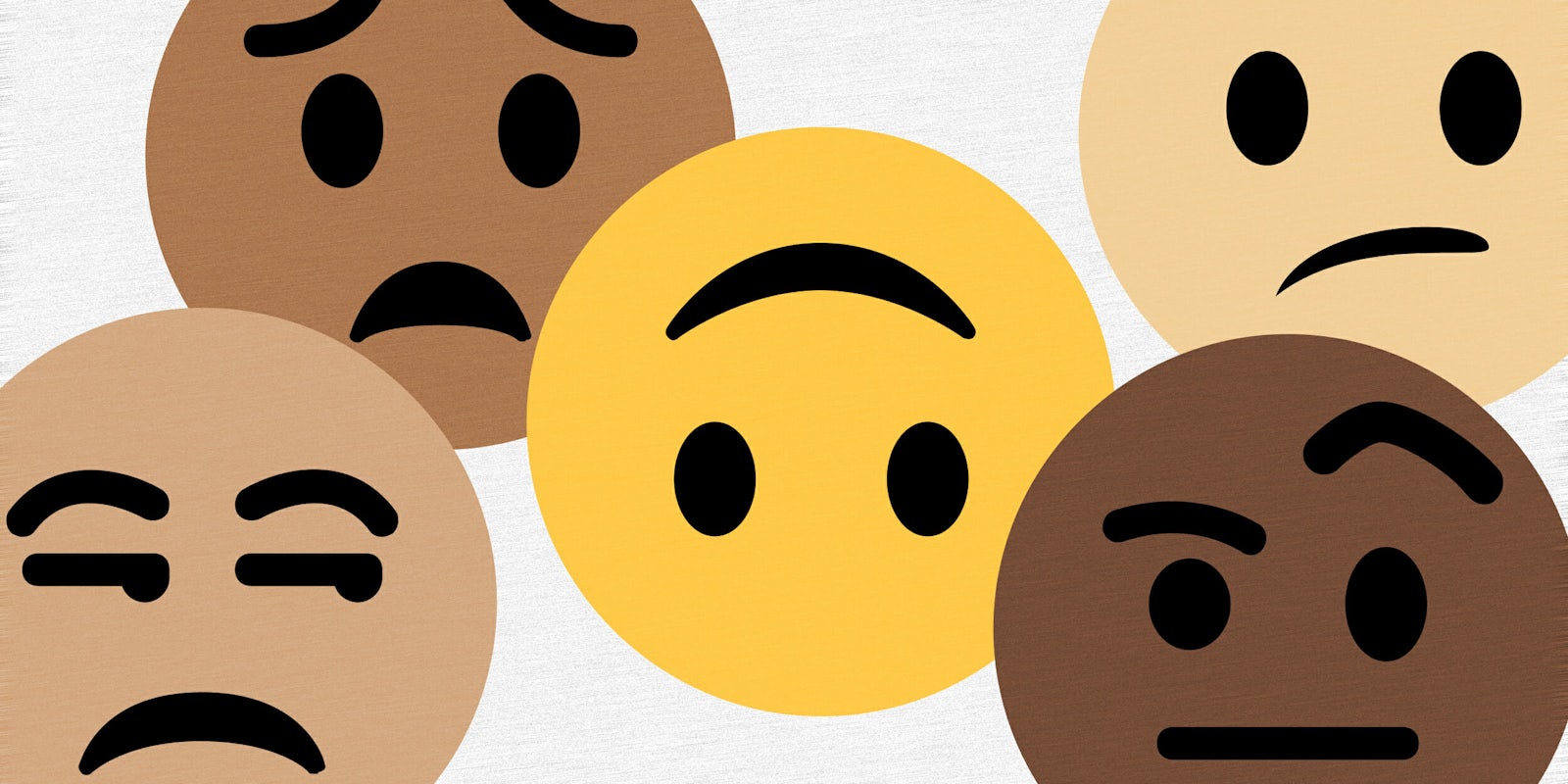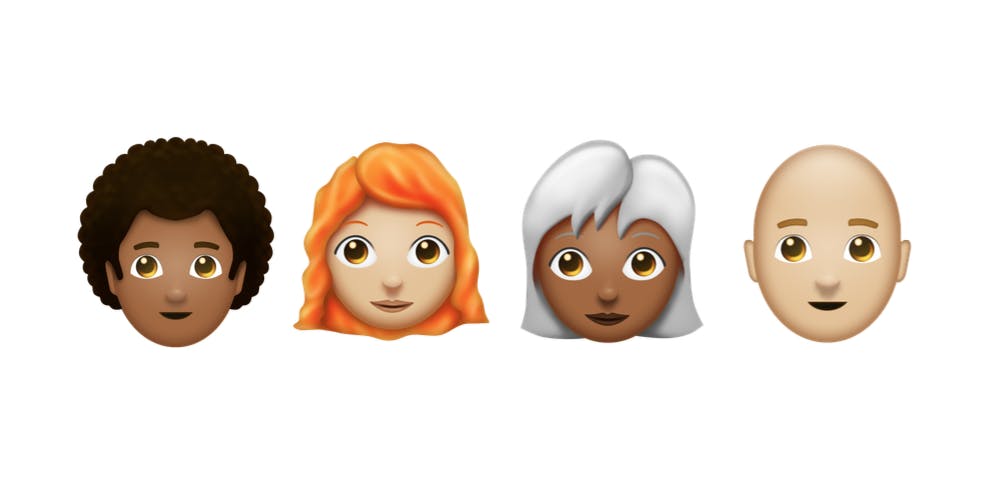By Zara Rahman
Recently, a friend of mine used the brown hand-waving emoji in a tweet to direct people’s attention toward a job posting. It was the kind of the thing that most of us do without much thought: Drop an emoji in a tweet to lighten it up. But when he pressed down on the waving hand, he had to make a choice, and when confronted with four other skin tones and the “default” yellow, he chose medium brown. Still, not a thing many of us would contemplate or notice. In fact, no one thought much of it as they retweeted him. But as a brown woman, I did. Because my friend and I do not share the same coloring. He’s white.
Skin tone emoji has been perceived as a smart and obvious answer to one of our everyday diversity problems in communication. After years of complaints about a lack of Black and brown representation, five skin tone options were introduced to emoji in 2015. The year prior, Apple revealed it had been working with the Unicode Consortium, a non-profit organization that decides how text and emoji are represented in software, to increase diversity in the emoji character set. The overall consensus, especially among people of color, was: It’s about time.
White people, however, seem to have had a less comfortable relationship to the skin-tone option. Two years after the emoji modifiers debuted, researchers at the University of Edinburgh examined half a billion tweets to see how they were being used and by whom. They discovered that “users with darker-skinned profile photos are more likely to use tone-modified emoji,” with the majority of those being similar in tone to the user’s profile photo. However, lighter-skinned users were less likely to use tone-modified emoji, they found.
Andrew McGill, who studied Twitter data for the Atlantic in 2016, backs this up. In the data he looked at, the lightest skin tone was used the least, even though white Twitter users outnumber Black users four to one. “Proclaiming whiteness [by choosing white emoji] felt uncomfortably close to displaying ‘white pride,’” he wrote. He found that white people in the United States were more likely to “opt out” of using the skin tones and choose the yellow instead, apparently to “avoid the decision.”
You could say, for white people, the option of choosing and performing a skin tone provided a moment of awkward reckoning: They had to confront their whiteness, which is something they rarely have to do.
When I asked my friend why he used the brown emoji and not a lighter-skinned one, he said he felt that there was already an overrepresentation of white people, particularly in technology, the type of job he was highlighting.
But what he doesn’t understand is using a different emoji skin tone doesn’t change his white identity—it only masks it when it no longer serves him. Choosing that little brown hand, and assuming people will see his good intentions, is another form of privilege.
Letting users “opt in” to five different skin tones was never going to lead to true representation.
. . .
White people aside, there are many others with a complicated relationship to skin-tone emoji. There are those for whom the choice over how to identify, especially when it comes to “color,” has been a source of conflict in real life, not just when sending a text.
Friends across South and East Asia told me that their decisions about emoji use with friends and family from the region were governed by the colorism that is rife across the region. Fair skin is still perceived as the most beautiful ideal to aim for, and as a result, discrimination against darker-skinned people is sadly commonplace. In response to that colorism, people I spoke to told me that they deliberately choose darker-skinned emoji to take a stand against the perception of not wanting darker skin. Juliana Harsianti, a journalist from Indonesia, told me she chooses the dark brown skin tone in response to the colorism she sees in her region. “I want to show, at least to my circle of friends, that I’m proud to have dark skin,” she told the Daily Dot.
Across the continent of Africa, and among African-American people, users told me that the introduction of skin tone emoji was a welcome addition. Without too much afterthought, everyone I spoke to who had dark or Black skin told me that they consistently used the emoji skin tone that matched most closely to their actual skin color, and that they enjoyed the increase in visibility for something other than the yellow “norm.”
For me, a woman of Bangladeshi descent, being able to make my emoji brown was exciting and validating. Finally, I could assert my own identity online, casually but clearly. I use emoji far more now, and I enjoy it, too—but this is also because my own perception of my identity matches up with one of the five categories available to me. Or, at least it does now that I’ve become accustomed to these skin identifiers, and I know where I’m supposed to fit within the options provided.

While our diverse life experiences are fluid and context-driven, the emoji choices that are made available are concrete and limited. The introduction of “human-like” emoji—a term to describe the emoji that evoke some element of human experience, like hand-waving, a thumbs up, a man, woman, or child, any kind of person—gives us a perfect example of the limits of this kind of representation. Race, age, gender, and class can’t always be put in neat little categories. And, essentially, that’s what emoji are trying to do: They are a discrete set of images designed to convey information in a way that’s different than how we do with words. In order for a certain set of experiences to be represented, there have to be choices made about what makes the cut and what doesn’t. Decisions go into how those images are designed—and no design decision is neutral.
. . .
When the skin tone modifiers were introduced, they were based on the Fitzpatrick scale, which is a recognized standard for dermatology and based on how those skin tones react in UV light (for example, the darkest skin tone represents skin that tans very easily and never burns). In describing its skin tone changes, the Unicode Consortium released a technical report where it stated:
“General-purpose emoji for people and body parts should also not be given overly specific images: the general recommendation is to be as neutral as possible regarding race, ethnicity, and gender.”
This wording and desire are fascinating. Because of the way that the skin tones were added, as “modifiers” to the “general-purpose” emoji, there arose a need for a default, a color to which the skin tones would be added. But who is this “neutral” person they speak of? What is a neutral ethnicity, or a neutral race or gender?
These guidelines reminded me of my childhood, where the wax crayon color marked “skin” was pink; perfect for almost everyone in my class, except me. Or my experiences trying to purchase “nude”-colored tights, where “nude” was assumed to be a “fair skin tone,” as though only white people want to wear skin-colored tights. It wasn’t even that there were few options open to me—there were simply none in Northern England in the ’90s. A non-white experience was simply invisible, because white was, and is, the default.
Nevertheless, Apple played along with Unicode’s impossible challenge for neutrality, and the company and the other vendors interpreted this to mean making the human emoji yellow by default. Emojipedia, a website which extensively covers the ins and outs of emoji developments, described this change as follows:
“These Simpson-esque emojis might not be to everyone’s liking, but they do strive to make it clear that the default characters do not have a particular race or skin tone implied.”
The description that the “default” didn’t have a “particular race or skin tone implied” surprised me. To me, those yellow images have always meant one thing: white. Even in The Simpsons, there were yellow characters (the majority and the main characters), and then there were Brown and Black supporting characters, some of which landed squarely in the “offensive stereotype” category like Apu, making it very clear which marginalized human experience they were poorly attempting to represent.
But beyond the skin tone themselves, the image designs (the way that the hair falls; the shape of the eyes, etc.) didn’t change from their first iteration as lighter skinned people, to their “neutral” counterparts, whatever that would mean. Paige Tutt, writing in the Washington Post, highlights some of the limitations of this, for example, on how Unicode didn’t change the facial features of any of the emoji—a task which would have been much more involved. Instead, by just allowing for skin tones to be layered on top of already-designed emoji pictures, she describes “these new figures aren’t emoji of color; they’re just white emoji wearing masks.” For her, this attempt at inclusion actually succeeds in doing the opposite, underlining instead how few of the emoji actually look like her, with lip service paid to being “inclusive.”
The attempts of tech vendors and the Unicode Consortium to stick to “neutral” actually just emphasizes existing inequities that are present in the world today. It is, and was, naive to think that any kind of “neutral default” would be possible.
Despite the new affordances offered to those whose physical identities match with the one they want to perform online, Unicode Consortium’s efforts at inclusion leave many others confused and struggling to choose. If yellow is so neutral and “not white,” why didn’t my white friend just choose no option and keep the waving hand in his tweet yellow?
Unicode’s intent may have been good—to be inclusive of the experiences of their ever-growing user base—but this was always going to be an impossible game to win. Emoji skin tones are essentially like real life: White people still get to be the default, while many people of color feel left out of such rigid representation.
. . .
So how could, or should, we represent the true diversity of experience in emoji?
First and foremost, tech vendors should acknowledge that “neutral” was never going to be fair in the inequitable society that we find ourselves in; such accountability and recognition would at least lay the biases so they know what to overcome. On a more practical level, instead of only offering discrete classifications for different images, vendors should give users more control over what aspects can be customizable in emoji. It would empower users to share their own vision for what they look like.
Leil-Zahra, a Lebanese artist and researcher based in Berlin, finds the current range of options too “reductionist and simplistic,” and instead imagines an approach that would somehow allow users to have control over how they are represented rather than restricting them to a certain set of options.
For me, downloading those brown emojis in 2015 was affirming. But as someone who recognizes that everyone’s relationship to their skin color and their identity is different, I understood not everyone was going to feel the same way. Representation shouldn’t stop and start with five fixed categories. For representation to work, we need to show variation. We need white people to confront how much space they take up, too.


